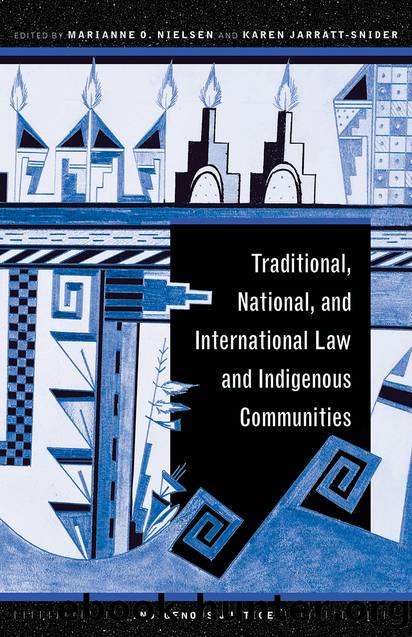Traditional, National, and International Law and Indigenous Communities by Unknown

Author:Unknown
Language: eng
Format: epub
Tags: SOC021000 Social Science / Ethnic Studies / Native American Studies, LAW110000 Law / Indigenous Peoples
Publisher: University of Arizona Press
Published: 2020-05-05T00:00:00+00:00
American Indian Tribal Sovereignty
There is a direct tie between a courtâs or agencyâs respect for the federal Indian Child Welfare Act and similar state laws and their understanding of tribal sovereignty. A review of state court proceedings involving Native American children reflects statesâ lack of understanding and respect for tribal sovereignty. That understanding is represented through the actions and failures to act by state agencies, governmental representatives, and the judiciary. The ICWA requires that the U.S. federal government, every state government, every Indian tribe, and all the territories of the United States give âfull faith and credit to the public acts, records, and judicial proceedings of any Indian tribe applicable to Indian child custody proceedings to the same extent that such entities give full faith and credit to the public acts, records and judicial proceedings of any other entityâ as reflected in the United States Code Section 25 U.S.C. 1912(d) 1988.1
While there are many definitions of sovereignty, Blackâs Law Dictionary (1979, 1252) defines sovereignty as âthe supreme, absolute and uncontrollable power by which any independent state is governed; supreme political authority; paramount control of the constitution and frame of government and its administration; the self-sufficient source of political power, from which all specific political powers are derived; the international independence of a state, combined with the right and power of regulating its internal affairs without foreign dictation; also a political society, or state, which is sovereign and independent.â
The courtsâ recognition of sovereignty is essential because American Indians were here first. Foreign settlers from a continent across the ocean came much later. The primary objects of the settlers were trade and land acquisition. Pommersheim (2009, 3) points out that the principal means of interactions between the colonies and the Indian tribes were diplomacy and war. He clearly explains that diplomacy and war often resulted in a treaty to settle the issue. Treaties are law. Treaties are binding contracts between two sovereign entities. After the colonies became the successor to the European states, the treaties were between the U.S. government and the individual sovereign tribes.
The foundation of the relationship between the government and the Indian tribes can be identified within the treaties, the Indian Commerce Clause of the Constitution, which reserved interactions and agreements with the tribes to a relationship between the federal government and those tribes, and the provisions to exclude âIndians not taxedâ from citizenship and from determining the number of representatives that each state was entitled. The interaction between the U.S. government and the Indian tribes resulted in more than 350 treaties (Pommersheim 2009, 3). The common focuses of the treaties were land acquisition and commerce agreements. The U.S. government, in congressional legislation, executive branch executive orders, and Supreme Court decisions, has formulated laws and policies that have set the framework for the interaction of tribal, federal, and state governments, including in matters of American Indian welfare.
Download
This site does not store any files on its server. We only index and link to content provided by other sites. Please contact the content providers to delete copyright contents if any and email us, we'll remove relevant links or contents immediately.
| Antitrust | Civil Law |
| Emigration & Immigration | Federal Jurisdiction |
| Housing & Urban Development | Indigenous Peoples |
| Land Use | Public |
| Public Contract | Public Utilities |
| Urban, State & Local Government |
Killers of the Flower Moon by David Grann(3263)
Machine Learning at Scale with H2O by Gregory Keys | David Whiting(2326)
Will by Will Smith(2077)
Guns, Germs and Steel by Diamond Jared(1894)
Borders by unknow(1792)
The Room Where It Happened by John Bolton;(1725)
The Color of Law by Richard Rothstein(1581)
Once Upon a Broken Heart by Stephanie Garber(1526)
Water Rights and the Environment in the United States by John Burch(1417)
Friends, Lovers, and the Big Terrible Thing by Matthew Perry(1351)
Examples & Explanations: Administrative Law by William F. Funk & Richard H. Seamon(1334)
A Short History of War by Jeremy Black(1310)
The Strength In Our Scars by Bianca Sparacino(1285)
HBR's 10 Must Reads 2022 by Harvard Business Review(1262)
Pharmacy Practice and The Law by Richard Abood(1259)
That Every Man Be Armed by Stephen P. Halbrook(1244)
The Guarded Gate by Daniel Okrent(1227)
515945210 by Unknown(1219)
Injustices by Ian Millhiser(1204)
